

I started this page because of my disappointment in the utter lack of reliable information on this subject in the net and in readily available printed sources. There is much misconception about this device and what I have found is really anticlimatic. The name, Nahverteidigungswaffe, evokes certain ideas about what this weapon should do. In actuality it is not really a weapon. It is an accessory.
I couldn't find any direct evidence that would shed light on the development of this particular device. From what I did find it would seem that this system was developed due to combat experience with the external, turret-mounted Wurfbecher used to discharge smoke candles to provide concealment for tanks. There were instances of tank crews being incapacitated by the smoke from their own smoke when those candles were ignited by small arms fire. By moving the smoke discharge system under armor, the tank crews could be protected from this effect.
Many thanks to Mattias, Jean-Charles, Markus, Mike and Helge for their assistance and comments. (they know who they are).
DESIGN
The Nahverteidigungswaffe consisted of a circular plate and a launch tube that was bolted to the roof of the tank and covered with an armored plate. The launch tube had a hinged breech. The breech was opened and closed by the use of a locking handle. The handle was rotated 90 degrees clockwise to unlock the breech and allow it to be flipped upwards. After loading the breech was closed and locked by rotating the handle back 90 degrees counterclockwise. The base plate mounting had a locking screw to allow the operator to lock the NahVW in a particular direction. The launch tube was set at a fixed 39 degrees from the vertical. The diameter of the launch tube was 92mm.
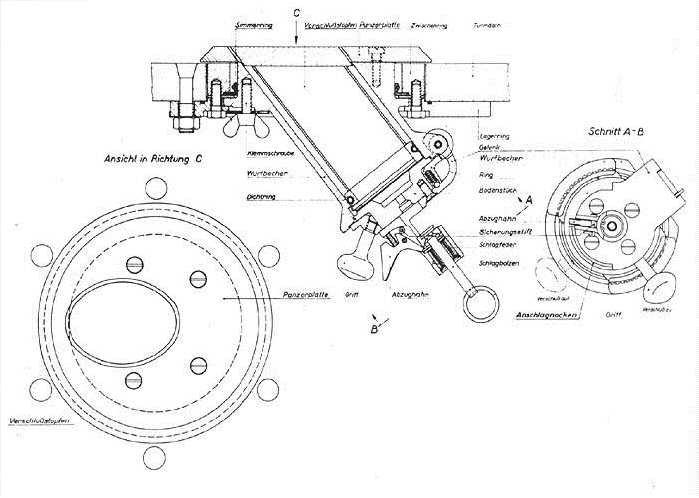
This image is from the Tiger B (Königstiger) turret manual. Many thanks to Mattias for his kindness in providing the image. A very big version of this image is available at The Big Picture. The Panzermuseum has posted their data from the Tiger B turret manual (D 656/42, Panzerkampfwagen Tiger Ausführung B, Turm Nr. 1 - 50 und Panzerbefehlswagen: Gerätbeschreibung und Bedienungsanweisung zum Turm, 1.2.1944) for those who would like to see the original German.
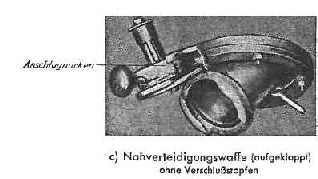
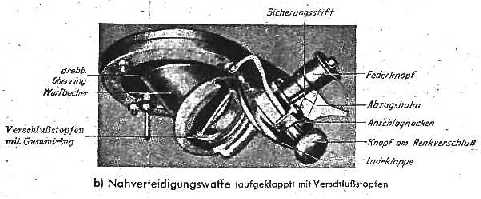
These two images show the Nahverteidigungswaffe in the open position. The one on the right shows the Verschlußstopfchen in place.
Ammunition
The Nahverteidigungswaffe could use a variety of ammunition types.
Schnellnebelkerze 39, smoke candles. This was the primary ammunition type and the one that determined the diameter of the launch tube (92mm).
A Sprenggranatpatrone of indeterminate type and nomenclature. The Tiger B manual calls for this round to be Sprenggranatpatrone 326 Lp. As will be shown below this must be in error. Whatever the name it was a high explosive round that had a range of 7-10 meters and with the timed fuze of 1 second would normally explode 0.5 to 2 meters above the ground. This round was fired from a normal Leuchtpistole (flare gun) or Kampfpistole (rifled flare gun) using the Nahverteidigungswaffe tube as a large pistol port. The caliber was "4-bore" and nominally 26.65mm but actually nearer to 26.9mm. Sources conflict on the size of the explosive charge. It was used to combat close assaulting infantry in the "dead zone" around the tank.
Rauchsichtzeichen orange 160, colored smoke cartridges
Leuchtpatronen, standard signalling munitions including starclusters and illumination rounds
Sprenggranate

The picture above and the drawing that follows below are of the original Sprengranatpatrone 326 Lp designed to be fired at ranges up to 400m. The impact fuze in the nose cone clearly indicates this. The round used to defend the vehicle had a timed fuze and wouldn't need an impact fuze. The round we're interested in had a thicker case and a bigger charge but it was still small. It was much smaller than the 5cm rounds used with the 5cm Light Mortar, le.Gr.W.36. This mortar was withdrawn from service because it was found to be ineffective. This calls into question the efficacy of the Nahverteidigungswaffe in defending vehicles from close assault. The HE charge was small and probably had less of an effect than a regular hand grenade fitted with a fragmentation sleeve. Research continues on the exact size and power of this grenade.
UPDATE:
I have been unable to locate any evidence of a special Sprenggranatpatrone 326Lp with a timed fuze as called for in the Tiger B manual. I have, however, found numerous references and photos of a special time-fuzed round designed for the Kampfpistole (also known as the "gezogene Leuchtpistole" - "rifled signal pistol"). Not much is known about this particular round. It was shrouded in great secrecy and documentation about its charcteristics is very rare. In the near future I will put up pictures of the round to compare with the Sprgrpatr. 326Lp above. What this would mean, then, is that the Tiger B manual was wrong when it called for the Sprgrpatr. 326Lp.
I have also found some numbers on the Sprgrpatr. 326 Lp itself. Development was started in 1937 and although the army later lost interest in it, the Waffen-SS was very interested in persuing its development. Though this round was advanced and well made, its performance was not as good other rounds of the same caliber. It was later replaced by a much simpler construction that had a bigger HE charge. This new round was called a 2.6cm Wurfgranate and sometimes mistakenly referred to as a "Sprengranatpatrone 326 Lp neuer Art", though its design had nothing in common with the original. Though this round had slightly better performance it effectiveness was still markedly inferior to that of the standard rifle grenade. Tests used by the Germans to measure this performance showed less effective fragmentation than the other comparable rounds like the impact-fuzed Sprengranate für Leuchtpistole Z (Kampfpistole).
In addition the Rauchsichtzeichenpatrone was also known as the Deutpatrone Z and like other cartrdges with the Z was designed to be fired from the Kampfpistole and could not be used with the normal Leuchtpistole. There was not, as far as I can deteremine, a comparable round for the normal Leuchtpistole. This would indicate that the Kampfpistole was the actual device used in conjunction with the Nahverteidigungswaffe.
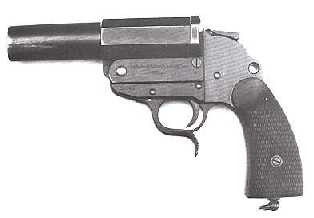
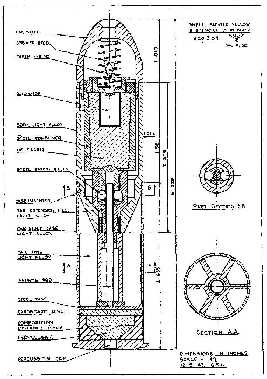
This is the standard Heeres Modelle Leuchtpistole (designed by Walther). To the right is a schematic of the Sprengranatpatrone 326 Lp showing its complexity and the small size of the HE charge. This drawing was made by the British. A bigger version is available here. Below is the Kampfpistole which easily identified by the prominent Z on the side and the addition of the circular sight on the frame.
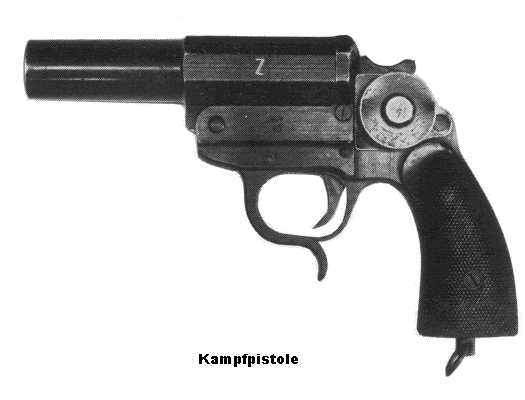
The following image taken from a late Tiger I manual shows clearly the method of using the Leuchtpistole/Kampfpistole with the Nahverteidigungswaffe. In this shot it is impossible to tell whether it is a Leuchtpistole or a Kampfpistole being used.
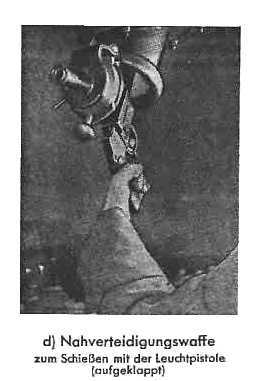
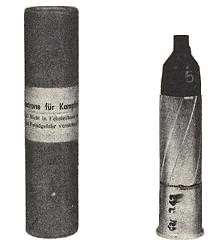
The round shown above is the standard HE round for the Kampfpistole hence the name Sprenggranate für Kampfpistole. It also shows how the round itself was rifled to fit in the Kampfpistole so that while the Kampfpistole could use Leuchtpistole ammunition, the Leuchtpistole could not fire these rifled cartridges.
Nebelkerzen
It is apparent that the primary function of the Nahverteidigungswaffe was to place smoke candles. The size of the tube was determined by the size of the Nebelkerzen. The original Nebelwurfgeräte mounted on many vehicles were removed after incidents of small arms fire igniting the candles in the dischargers and the resulting smoke incapacitating crew members. The Nahverteidigungswaffe allowed the smoke candles to be discharged from under armor. The Nebelkerzen were the only munition that the nahverteidigungswaffe actually "fired." The rest were fired using the Leuchtpistole/Kampfpistole.
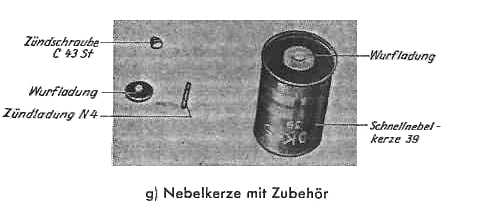
This image shows the Schnellnebelkerze 39 and accessories:
The Zündladung N4 is the blasting cap used to activate the smoke candle after discharge. It was inserted into the bottom of the smoke candle and then the Wurfladung was screwed into the cover the Zündladung. The round was then inserted into the launch tube.
After the breech was closed the Zündschraube C43 St was inserted into the breech cavity and used to fire the Wurfladung and thus the smoke candle.
Vehicle Mountings Sources Contact
Last Updated 04/02/00 23:31 CET